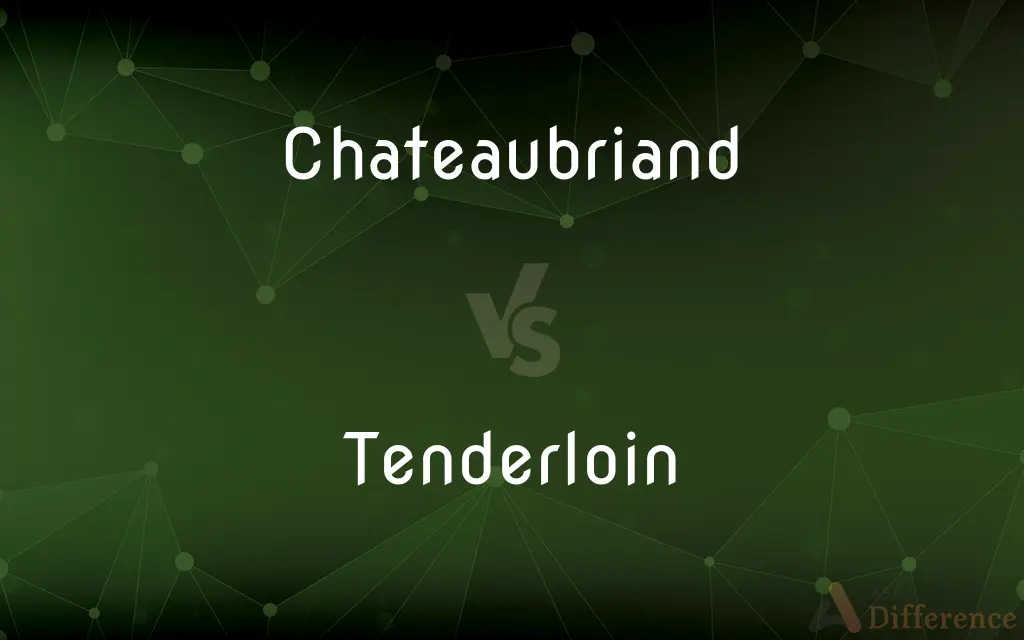Chateaubriand vs. Tenderloin — What's the Difference?
By Urooj Arif & Fiza Rafique — Updated on April 14, 2024
Chateaubriand is a thick cut from the tenderloin used primarily for roasting, while tenderloin is a long, narrow, and lean muscle extending along the spine.

Difference Between Chateaubriand and Tenderloin
Table of Contents
ADVERTISEMENT
Key Differences
Chateaubriand is a specific cut from the beef tenderloin, known for its tenderness and being served as a large, center-cut piece ideal for roasting. On the other hand, the tenderloin itself is the entire muscle from which various steak cuts are made, including Chateaubriand, filet mignon, and others.
Traditionally, Chateaubriand is prepared by roasting and is often thick enough to serve two to four people, highlighting its status as a luxury dish. Whereas tenderloin can be cooked in various ways, such as grilling, pan-frying, or roasting, making it versatile in culinary use.
Chateaubriand, due to its thickness and typical preparation, is usually more expensive per pound compared to other cuts from the tenderloin, which might include thinner or smaller steaks like filet mignon. Conversely, tenderloin offers a range of price points depending on the specific cut and size.
While Chateaubriand is best known in French cuisine, recognized for its preparation and presentation, tenderloin is utilized globally in countless recipes, reflecting its universal culinary appeal.
The cooking time for Chateaubriand is generally longer due to its size, often requiring careful temperature management to achieve the desired doneness. In contrast, tenderloin steaks may cook much quicker, especially if sliced thinly.
ADVERTISEMENT
Comparison Chart
Part of the Cow
Center-cut from the tenderloin
Entire muscle along the spine
Common Cooking Methods
Roasting
Grilling, pan-frying, roasting
Serving Size
Large enough for two to four people
Varies, often individual servings
Price
Generally more expensive per pound
Varies, generally less expensive per smaller cuts
Culinary Tradition
Predominantly French
Used globally across various cuisines
Compare with Definitions
Chateaubriand
Traditionally served as a meal for two, often roasted.
Their anniversary dinner featured a perfectly cooked Chateaubriand.
Tenderloin
Versatile in cooking methods, suitable for various dishes.
She experimented with grilling the tenderloin with different spices.
Chateaubriand
Known for its tenderness and rich flavor.
The chef praised the Chateaubriand for its buttery texture and succulence.
Tenderloin
The most tender cut of beef, located along the spine.
He chose a tenderloin steak for its renowned softness.
Chateaubriand
A thick cut from the beef tenderloin intended for roasting.
For a special occasion, they prepared a Chateaubriand with a béarnaise sauce.
Tenderloin
Widely used in both casual and gourmet recipes.
The cooking class taught them how to prepare tenderloin in several ways.
Chateaubriand
Considered a luxury or gourmet dish in French cuisine.
The menu highlighted Chateaubriand as the premium option.
Tenderloin
Preferred for its low fat content and lean texture.
Diet-conscious diners often select tenderloin for its leanness.
Chateaubriand
Frequently accompanied by a sauce, such as béarnaise.
They served the Chateaubriand with a side of creamy béarnaise.
Tenderloin
Often cut into smaller steaks, including filet mignon.
They offered both filet mignon and larger tenderloin roasts.
Chateaubriand
A double-thick, tender center cut of beef tenderloin, sometimes stuffed with seasonings before grilling.
Tenderloin
The tenderest part of a loin of beef, pork, or similar cut of meat.
Chateaubriand
A thick, juicy cut from the center of a beef tenderloin.
Tenderloin
A city district notorious for vice and graft.
Chateaubriand
A double-thick center cut of beef tenderloin, broiled and served with a sauce and potatoes.
Tenderloin
The tenderest part of a loin of meat, especially of pork or beef.
Chateaubriand
French statesman and writer; considered a precursor of the romantic movement in France (1768-1848)
Tenderloin
A district of a city where corruption is common, often because the district is devoted to questionable businesses (peep shows, etc) which are easy for police to blackmail and extort.
Chateaubriand
Double-thick center cut of beef tenderloin
Tenderloin
A strip of tender flesh on either side of the vertebral column under the short ribs, in the hind quarter of beef and pork. It consists of the psoas muscles.
Tenderloin
In New York City, the region which is the center of the night life of fashionable amusement, including the majority of the theaters, etc., centering on Broadway. The term orig. designates the old twenty-ninth police precinct, in this region, which afforded the police great opportunities for profit through conniving at vice and lawbreaking, one captain being reported to have said on being transferred there that whereas he had been eating chuck steak he would now eat tenderlion. Hence, in some other cities, a district largely devoted to night amusement, or, sometimes, to vice.
Tenderloin
A city district known for its vice and high crime rate
Tenderloin
The tender meat of the loin muscle on each side of the vertebral column
Common Curiosities
What is Chateaubriand?
Chateaubriand is a thick cut from the tenderloin, typically roasted and served as a dish for two to four.
What cooking methods are suitable for Chateaubriand?
Roasting is the traditional method for preparing Chateaubriand.
Can tenderloin be cooked quickly?
Yes, especially when cut into smaller, thinner steaks like filet mignon.
What is the ideal doneness for tenderloin steaks?
Medium rare is commonly preferred to maintain tenderness and flavor.
Why is Chateaubriand more expensive?
It is a premium cut known for its size, tenderness, and association with French gourmet cooking.
How should Chateaubriand be seasoned?
Simple seasonings are recommended to highlight its natural flavors.
How is tenderloin different from Chateaubriand?
Tenderloin refers to the entire muscle, while Chateaubriand is a specific, large cut from it.
Are there any dietary benefits to eating tenderloin?
It's known for being lean and low in fat, making it a healthier red meat option.
What dishes feature tenderloin?
Tenderloin is versatile, featured in dishes like steak sandwiches, beef Wellington, and more.
Is Chateaubriand always served with sauce?
While often served with sauces like béarnaise, it's not mandatory.
Share Your Discovery

Previous Comparison
Dotting vs. Doting
Next Comparison
Cooking vs. CuisineAuthor Spotlight
Written by
Urooj ArifUrooj is a skilled content writer at Ask Difference, known for her exceptional ability to simplify complex topics into engaging and informative content. With a passion for research and a flair for clear, concise writing, she consistently delivers articles that resonate with our diverse audience.
Co-written by
Fiza RafiqueFiza Rafique is a skilled content writer at AskDifference.com, where she meticulously refines and enhances written pieces. Drawing from her vast editorial expertise, Fiza ensures clarity, accuracy, and precision in every article. Passionate about language, she continually seeks to elevate the quality of content for readers worldwide.
















































